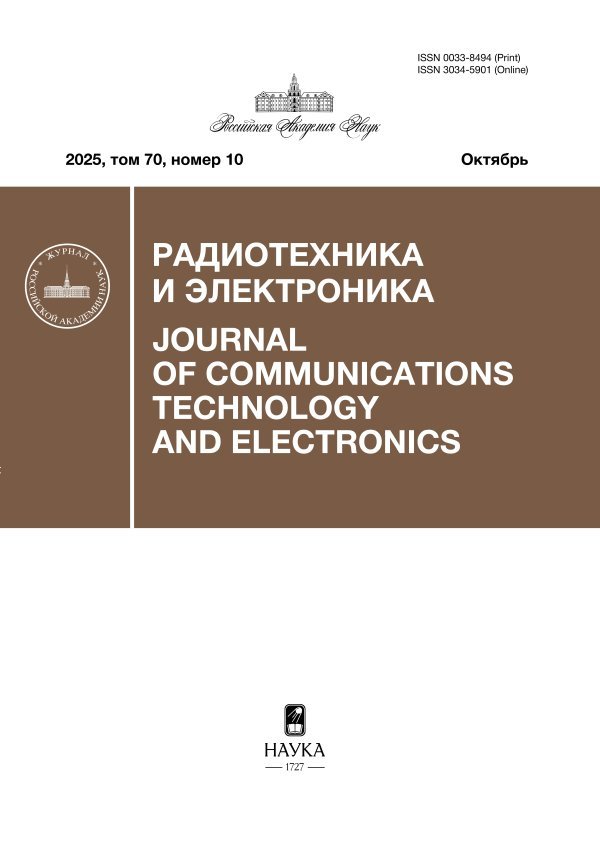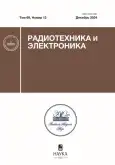Simple model for calculation of radiation parameters of a unidirectional flat openingv
- Authors: Ostashev V.E.1
-
Affiliations:
- Joint Institute for High Temperatures of Russian Academy of Sciences
- Issue: Vol 69, No 12 (2024)
- Pages: 1139-1149
- Section: ELECTRODYNAMICS AND RADIO WAVE PROPAGATION
- URL: https://modernonco.orscience.ru/0033-8494/article/view/682384
- DOI: https://doi.org/10.31857/S0033849424120017
- EDN: https://elibrary.ru/HNGIKG
- ID: 682384
Cite item
Abstract
A model for calculating the radiation parameters of a flat aperture in the far zone of free space is described. The electromagnetic field on the aperture is specified by the field of the primary polarized wave emanating from the excitation point. The radiating system is represented by Huygens elements. Verification of the reliability of the calculation result is carried out at the level of agreement with fundamental physical principles, with analytical calculations, and with the experimental results. When the antenna is excited by an arbitrary electric pulse, the calculation time of the radiation parameters in the time, space, and frequency domains is a few minutes. The calculation model is equipped with an interface in the style of MS Windows.
Full Text
About the authors
V. E. Ostashev
Joint Institute for High Temperatures of Russian Academy of Sciences
Author for correspondence.
Email: ostashev@ihed.ras.ru
Russian Federation, Izhorskaya str., 13, Bild. 2, Moscow, 125412
References
- Марков Г. Т., Сазонов Д. М. Антенны. М.: Энергия, 1975.
- Skulkin S. P., Turchin V. I. // IEEE Trans. 1999. V. AP-47. № 5. P. 929.
- Skulkin S. P., Lysenko N. A., Uskov G. K., Kascheev N. I. // IEEE Antennas and Wireless Propagation Lett. 2019. V. 18. № 5. P. 1036. http: doi.org/10.1109/LAWP.2019.2908455
- Skulkin S. P., Lysenko N. A., Uskov G. K., Bobreshov A. M. // IEEE Antennas and Wireless Propagation Lett. 2020. V. 19. № 9. P. 1516. http: doi.org/10.1109/LAWP.2020.3008116
- Kурушин А. А., Пластиков А. Н. Проектирование СВЧ устройств в среде CST Microwave Studio. М.: МЭИ, 2011.
- Банков С. Е., Курушин А. А. Расчет излучаемых структур с помощью FEKO. М.: НПП «Родник», 2008.
- Вайнштейн Л. А. Электромагнитные волны. 2-е изд. М.: Радио и связь, 1988.
- Осташев В. Е., Ульянов А. В., Федоров В. М. // РЭ. 2020. Т. 65. № 3. С. 234.
- Осташев В. Е., Ульянов А. В. // РЭ. 2021. Т. 66. № 11. С. 1.
- Lee R. T., Smith G. S. // IEEE Antennas and Propagation Magazin. 2004. V. 46. № 1. P. 86.
- Осташев В. Е., Ульянов А. В. // РЭ. 2023. Т. 68. № 12. С. 1149.
- Авдеев В. Б. // Радиотехника. 1999. № 6. С. 96.
- Fedorov V. M., Efano M. V., Ostashev V. Ye. et al. // Electronics. 2021. V.10. № 9. Article No. 1009101. https://doi.org/10.3390/electronics10091011
- Введенский Б. А., Аренберг А. Г. Распространение ультракоротких радиоволн. М.: Сов. радио, 1938.
- MIL-STD-464C «Electromagnetic Environmental Effects Requirements for Systems». Wright-Patterson: AFB, 2010. 165 p. http://everyspec.com/MIL-STD/MIL-STD-0300–0499/MIL-STD-464C_28312.
Supplementary files





















